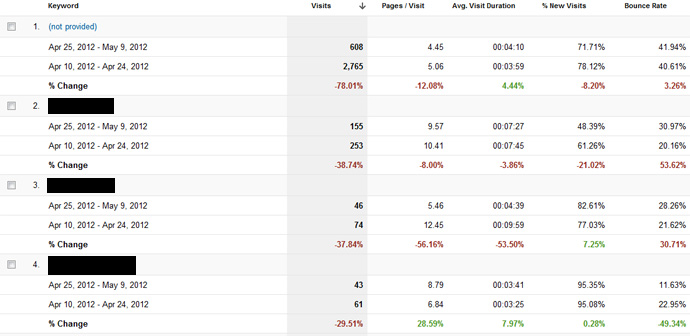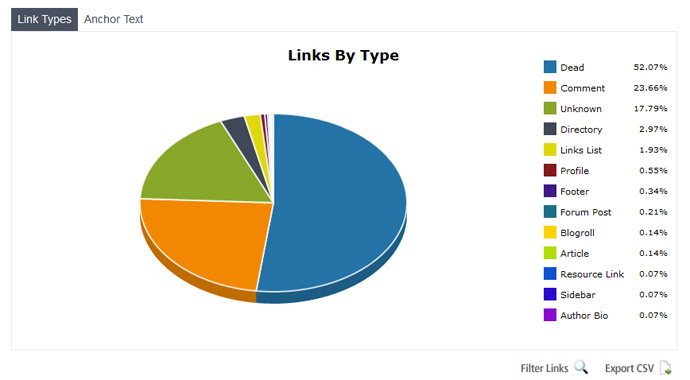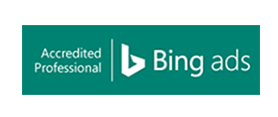It has now been a few months since the April / May fiasco where Google kicked off a series of ranking algorithm updates with a bug affecting several sites causing panic and confusion which they then followed with a Panda update on 19th of April. They then proceeded to roll out the new Google Penguin filter on the 24th of April that agressively targets spam links designed to artifically inflate the rank of a site or certain pages within a site & wrapped up April with another Panda update on the 27th.
This combination of events has led to some confusion for webmasters who don’t know whether they have been hit by the Panda, Penguin or one of the other search quality updates Google has rolled out this year such as the removal of link networks, removal of directory sites or anything else aimed at rewarding quality and penalising the dirge (that’s your new SEO mantra: don’t be the dirge).
There is a sunny side to all of this and now with three months behind us we are seeing some solid strategies for diagnosing and resolving penguin issues in many cases. Additionally, we are long overdue a penguin update and the rumour mill would have us believe that the filter is going to get more aggressive. So, without any further ado, the rest of this post will focus on just how you can go about identifying, preventing and resolving your Penguin problems where possible.
What is Penguin
Penguin is what Matt Cutts referred to (and was made to regret) as an over optimisation penalty and one that focuses primarily on external factors. Penguin is going to examine your entire link profile, look for over optimised anchor text being primarily too many exact match anchors (‘my dream keyword’), a lack of branded and natural anchors and too many links from poor sites.
A quick and simple way to check your anchor text is via the SEOMoz linkscape index and Open Site Explorer tool. This tool maintains its own index of the web and even in the free mode will show you your top five anchor text terms. If these top five terms are keywords that you have targeted, then chances are you are going to have a problem.
Penguin Diagnosis
Much like the Panda penalty before it, Penguin is a rolled out by Google in stages and if you are hit, or resolve your problems, recovery will not come around to the filter refreshes. So, this fact, that the Penalty hits on very specific dates gives us our first clue to use in diagnosing whether we have a penguin problem or something else entirely. First job is to check your analytics and determine if there was a drop on a known penguin date.
Penguin Dates: April 24th & May 25th (so far)
If you saw a significant drop off in traffic on one of those dates then odds are you have been visited by a Penguin. To confirm this just log into your analytics and select just the ‘non-paid search traffic’ and a date range from two weeks before your suspected penalty to two weeks after. This will show you a clear drop in your organic traffic that will look something like this:

Now, to see just how bad things are lets use Google’s compare feature and compare traffic for the two weeks before & the two weeks after your penalty. So, if you got hit by the first round on the 24th of April then you would select 25th of April to the 9th of May and then select the ‘Compare to Past’ option below the date which will auto populate the 10th of April to the 24th of April.
Now, you are going to see two lines – one showing the post penguin time period and then the pre-penguin time period. We are also going to see some statistics detailing the difference in traffic for the second time period and if you have been hit, it’s going to be pretty drastic – likely 50% plus. And, just to be sure there are no compounding factors browse down to Traffic Sources > Sources > Search > Organic (or use the non-paid search segment).

So, as you can see in this example, organic visits were down 65% which in this example was 20,370 visits in the two weeks preceding the penalty and only 6,974 in the two weeks after the penalty – pretty brutal.
What Keywords Were Affected
Now, Penguin is a pretty clever system, in that, it does not just carpet bomb your entire site, it actually focuses on the problematic anchor text so before we start any kind of clean-up we first need to do some digging and see exactly which keywords have been affected.
So, if you browsed down to Traffic Sources > Sources > Search > Organic and have kept the screen open, below the two lines and statistics we can see the difference in search traffic from those keywords and what we are looking for are the red ones – the ones with a minus value showing a considerable drop over the preceding two weeks.
Your screen will show something like the below. If your biggest keywords were not hit, then just keep scrolling through and make a list of all the keywords that have seen significant drops in traffic.
Affected Keywords – Keywords changed to protect the (not so) innocent

So, we can see some pretty big drops for provided keywords: -38%, -37%, -29% and there are plenty more of these if we dig down the link profile. So, compile these into a list and we now we have a list of affected search terms so the next job is to match this up against your link profile and determine just which links are causing the problems so you can attempt to remove or edit those links.
Identifying Toxic Links
One of the easiest way to identify all of these problem links is another tool called Link Detective. You are going to need to get a pro account on SEOMoz to use the Open Site Explorer tool to export your entire backlink profile but they do a free 30 day trial so this is an important step and again, won’t cost you anything if budget is an issue.
Link Detective
Now, it’s time to get your Sherlock Holmes hat on and dive into your link profile in a little more detail within link detective. You will need to register, set up a project and upload your backlink profile that you grabbed from the SEOMoz Open Site Explorer tool. Link Detective will now review your entire backlink profile (it’s quicker if you register a paid account) and provide you with a breakdown of your links by type.

This is pretty useful to get an idea of what your links and even your competitors look like but in this instance we just want to use this tool to identify our potential problem links. To do this we click on the ‘Filter Links’ icon in the bottom right and select the anchors that we listed whilst digging through our analytics. You can now click on the ‘Export CSV’ button to generate a spreadsheet of all of your potential problem links.
Fixing the problem
The final step is to weed through the data and try and identify any problem links so you can determine if you can fix this and then (attempt) to get them removed. It makes sense to approach this in a structured fashion and start with either the terms that lost the most traffic or the terms that had big traffic losses that made you the most money (likely to be one and the same but not in all cases).
To do this I would export one keyword at a time from Link Detective so you have a single spreadsheet for each term. You can then use the various metrics in the spreadsheet to structure your approach. The link detective spreadsheets are already ordered by the domain authority but you can check the page authority, links to domain, links to page etc and use those to order the data should you need to refine your approach. Personally, I would reorder these spreadsheets so they are ordered primarily by domain authority and then by page authority in ascending order so you can start with the low (and likely more spammy) sites first and work through the list.
Should you start over?
A horrible question, but unfortunately, one that needs to be asked and it’s also a pretty tough one to answer. Ultimately, it depends on just how bad things are. If you have mostly exact match anchor links from low quality sites and little in the way of natural or high quality branded links then you could be in trouble. To fix this you are going to have to do some serious marketing and link building, guest posting etc to normalise your link profile and that’s without factoring in the vast body of work that is required to attempt to get links removed.
If you have lots of anchor text links, footer links and such from a series of sites you control or where you can have the links removed then there is a good chance you can fix the ratio by removing these links.
Ultimately, it all depends on your unique situation+ the state of play within your topical niche and only by identifying what is normal and figuring out what you need to do to get to normal (or beyond normal) can you make that judgement call.
Hopefully, the simple tools in this article will at least give you the tools to recover or at the very least, if you have to make a call on this, and rebrand, then you can get moving on that and start taking steps to get back to square one with some valuable lessons behind you.
As ever, if I can help, drop a comment below or get in touch.






